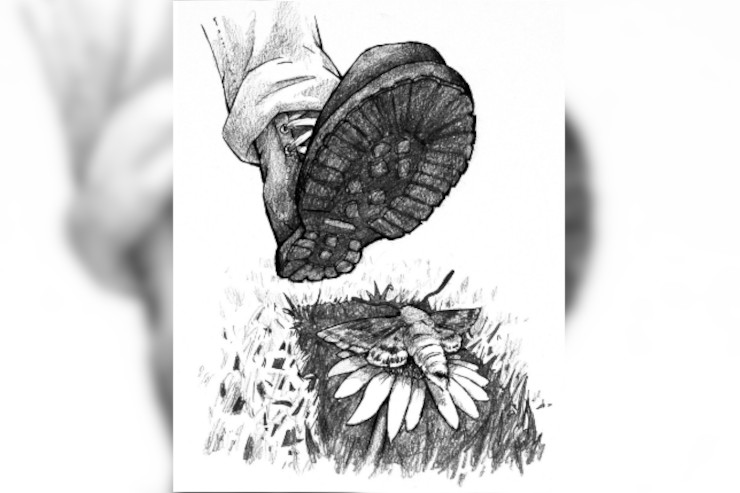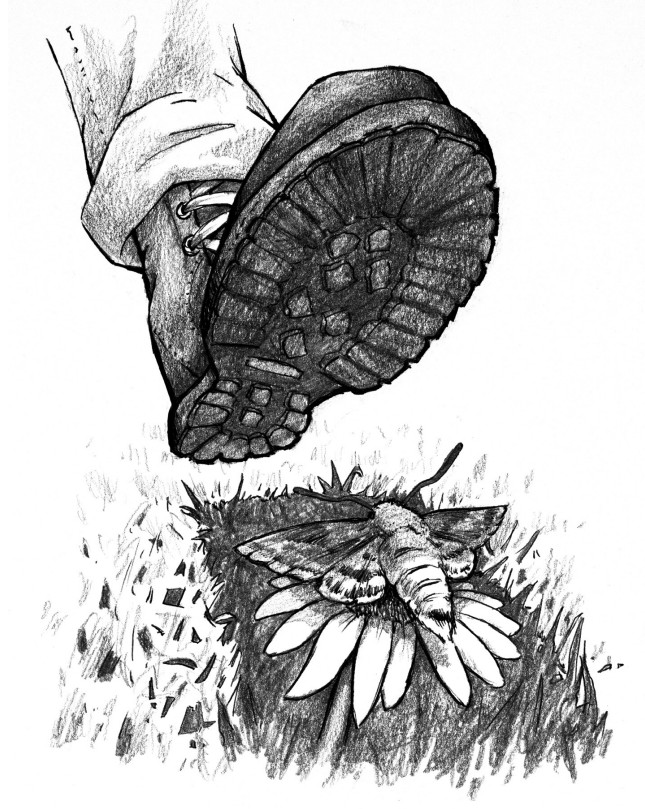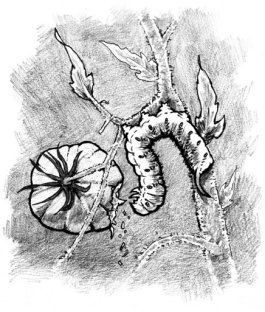
For most gardeners, the sight of a tomato hornworm is a call to action. These enormous green caterpillars can decimate your tomato plants in mere seconds. (Okay, maybe not seconds, but it seems that way.) Few of us, however, think about the hornworm’s parent–the tomato worm moth, also known as the hawk moth.
The USDA refers to the tomato worm moth as a “super tanker.” Hawk moths, as a species, have the longest tongues in the butterfly and moth world, with some extending up to 14 inches long. Despite their size, they often go unseen by gardeners due to their excellent camouflage and their nocturnal nature.
Elton A. Foster is an exception. In his story, Death in the Garden, Elton shares his experience finding a tomato worm moth near his garden and the ensuing moral dilemma he has in eradicating the moth before it can produce another generation of hornworms that will destroy his tomatoes.
Now, you might think it would be easy enough to get rid of a moth that’s about to wage war on your tomatoes. And you might think Elton, after days of plucking and snipping hornworms with gardening shears, would be more than happy to rid his garden of the source of future hornworm hordes. But it’s not that simple.
From the Great Tomato Worm Moth to the Smallest of Garden Creatures, You’ll Find Their Stories Here In GreenPrints.
This story comes from our archive that spans over 30 years, and includes more than 130 magazine issues of GreenPrints. Pieces like these that turn gardening stories into everyday life lessons always brighten up my day, and I hope this story does for you as well. Enjoy!

Death in the Garden
Killing a tomato hornworm is one thing. Killing its mother?
By Elton A. Foster
I am a Southern organic gardener on the Louisiana Gulf Coast, near New Orleans. We plant early here, knowing that by mid-July, our tomato plants become shriveled, yellowing, bug-chewed masses of vines with little more to show for themselves. I started in mid-March, with successive plantings throughout the garden in April and May. By late May, my March tomato vines were seven feet tall and brimming with ripening fruit. By early June, the first crop had already been harvested with many more coming in to take their place.
Then: the onslaught. Like a barbarian horde had appeared overnight, my plants were suddenly overwhelmed by Manduca quinquemaculata, better known as the—dreaded—tomato hornworm, just a few of which can strip a seven-foot-tall vine bare in two days. Flourishing basil and fresh mozzarella were ready for the next crop to join them on the plate. Neighbors were clamoring for handouts of juicy goodness. The onslaught had to be stopped—now. I immediately plucked those I could find off of the vines, snipped them in two with my garden shears, and tossed the gooey, green remains into the storm drain.
I didn’t give much thought as to where these creatures came from or where they ended up if I didn’t decimate them. All my efforts were focused on eradication. I did examine them, though, and found that they weren’t really ugly, but rather a bit clownish. In fact, they were cute (kind of), with their chartreuse coats, twirly faux-horn on rump, puppy-like false eyes, and six little paw-like forearms (if you can call them that). Yet I didn’t feel even a brief twinge of “Sorry, little guy,” when I sliced them in two with my shears. They were after my tomatoes!
After a couple of days of search and destroy—literally plunging my head and arms into my vines to follow the trails of caterpillar poop—I sprayed all the vines with the organic bug killer spinosad. I was careful to get under the leaves where they sometimes hide.

That’s when I noticed something even more menacing and insidious: the (also-dreaded) tomato fruit worm. Yes, many—if not most—of my green, pink, and red fruits were almost inconspicuously drilled, chewed, and pooped in: ruined. And when I’d find a plump tomato that looked unscathed, I’d reach for it and grab a gross, soupy, slime of oozing juice and caterpillar crap, sometimes with the caterpillar entwined in my fingers. This was followed by another blitzkrieg of spinosad. Finally, the biological warfare got things under control. The hornworms disappeared and the fruit worms lessened.
As it turns out, hornworms change into one of the most beautiful and graceful creatures of the insect kingdom: hawk moths. Hornworms, once satiated and after checking their calendars, descend the vines into the ground, make little hard-shell cases around themselves and quietly transform. Once they emerge from their safe little shells in the ground, they are birdlike creatures, more so than any butterfly. And like hummingbirds, they flit to and hover over nectar-rich flowers, extending their long proboscises to sip a sweet meal. Their only other interest is finding a mate. They are big bugs; bigger than many hummingbirds, with fat colorful bodies supported by large and powerful wings. And quite unbug-like: they appear and even feel feathery.
Yet butterflies like the monarch or swallowtail get all the love. People rush out in Spring to buy up the gallon containers of milkweed at garden centers so they can actually nurture monarch caterpillars along to winged glory. Not so the moth. Perhaps it’s because they tend to be creatures of the night, with a certain nocturnal creepiness made worse by movies like Silence of The Lambs and The Mothman Prophecies.
And now for my dilemma. I am one of many who thinks that killing a child, human or animal, seems generally more egregious than killing an adult. But I had no such moral dilemma in squashing, slicing, or drowning these young caterpillars (who had no such qualms ending the lives of my tomato plants). I had no remorse at all—until I found a hummingbird moth in waning daylight resting on a brick wall of my house within inches of my rescued tomatoes. I realized at least one hornworm must have escaped my warfare and become what Nature intended: a beautiful hummingbird moth, quietly resting before taking its dusk flight in search of nectar and a mate. Or was she done mating? Had she already laid her tiny, inconspicuous, pearl-like eggs on the undersides of my tomato vines? Was she about to?

I didn’t take any chances. I grabbed a can of bug spray used primarily for mosquitoes on the deck (betraying my own pledge to never use chemical insecticides in the garden) and let her have it—with blast after blast of spray.
I felt an immediate wave of remorse for what I had done, even if it had been for the greater good of my tomatoes.
And then came my rationalizations: If it wasn’t for that blasted moth, there wouldn’t be any hornworms to kill. I had spared future caterpillars from getting killed by me by making sure they’d never be born. Besides, I hadn’t actually used a chemical pesticide in the garden—only near the garden—which doesn’t count. My rationalizations were turning into absurd mind theater.
My regret grew when I watched the moth fall from the wall and struggle across the grass, frantic at first but slowing. I hoped it would die a quick death but, perhaps because of its size, it didn’t. I felt as though I had sprayed a tiny bird with insecticide. This thought hurt. I even thought of grabbing the poor thing and washing it off with the hose—but quickly dismissed that as lunacy: the damage was already done. I could kill the children. But the beautiful, graceful adult proved far more emotionally complex for me. And this for a moth whose offspring do great harm to my garden!
In the morning, I woke, and as I always do before leaving for work, checked the tomatoes for harvestable ones, critter damage, etc. I knew where the moth lay, about eight feet from the garden in the grass. I didn’t want to look. But I just had to see the aftermath of what I had done. Surely I’d find her dead as a doornail and that would be that. No such luck. A splayed wing twitched. I hoped it was just from the breeze I felt on my neck. I looked closer. Legs twitched as well, below the tops of the grass blades, where the wind could not find them. My heart sank, I knew I had to do what I should have done the evening before: squash her. I felt like I did when I took my beloved Max, a black lab of many years, to the vet to be euthanized after his terrible bout of bone cancer. Only this time I was the cause of all this misery.
This experience has changed me, unlike any other gardening experience, good or bad. I don’t think I did a terrible thing or even a bad thing, but I don’t really know. All I know is that I feel awful for doing it. By early July, my later successive plantings were brimming with green fruit showing the slightest hints of blush. No sign yet of more insect pests.
But what should I do the next time they come? What if next year I grow some extra tomato plants away from my garden crop—and move any insect pests—excuse me, those whom nature calls to the table—to there? ❖
By Elton A. Foster, published originally in 2023, in GreenPrints Issue #134. Illustrated by Christopher Reid

Have you faced a moral struggle with ridding your garden of damaging pests? I’d love to read about it in the comments.




Yes, I even feel bad when knocking Japanese beetles off of my blueberries in to soapy water and watch them struggle to get out. But without doing it will not have any blueberries. (Note to self, spray nematodes or BT next spring which will kill the grubs without me seeing it)